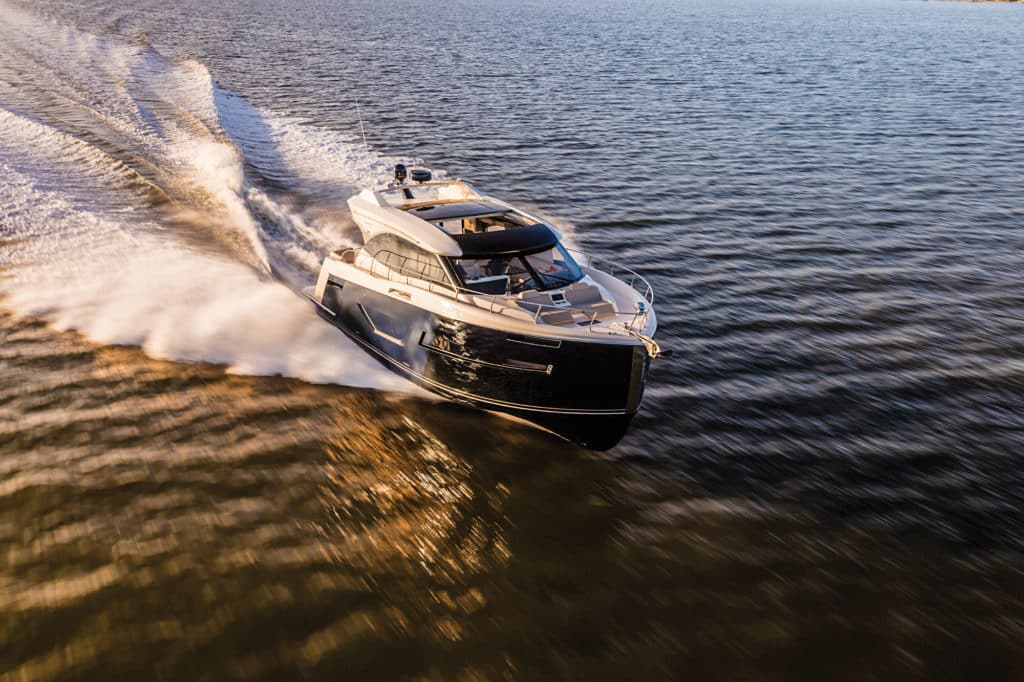
Based on the C52 Command Bridge launched in early 2016, Carver’s new C52 Coupe was one of the must-see models this past fall. The Wisconsin builder’s dockside booth at the Fort Lauderdale International Boat Show was overflowing with yachtsmen who wanted to step aboard the black-hulled C52 Coupe — which is a beauty inside and out. “We knew this would be our flagship for a long time, so we decided to go above and beyond,” says Josh Delforge, vice president of product development and engineering at Carver. “We wanted to show exactly what we could do with this new generation of Carvers.”
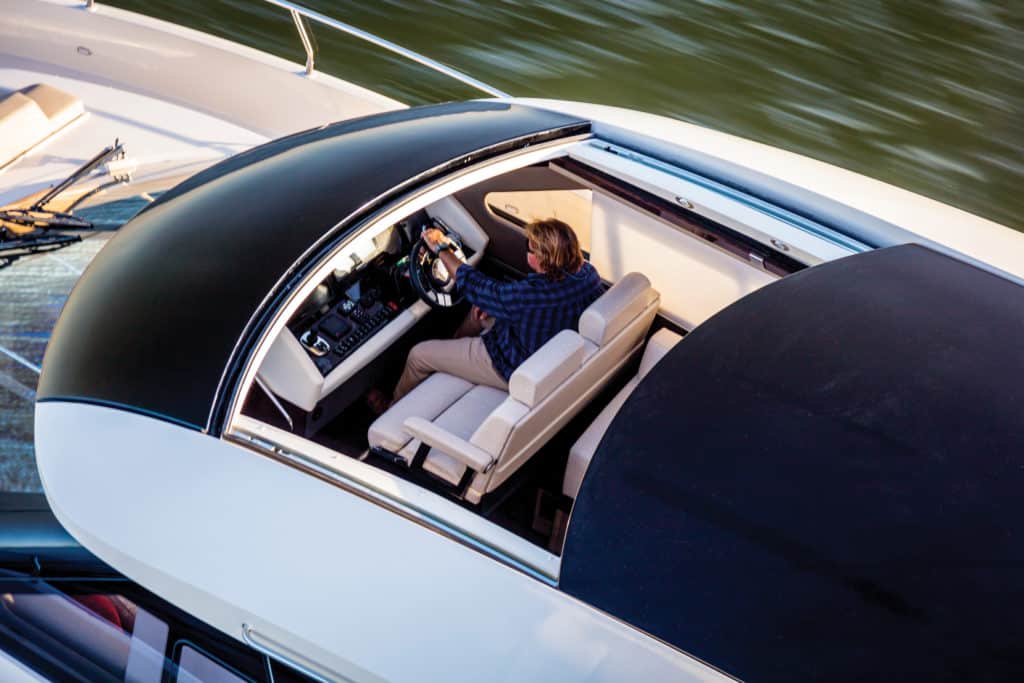
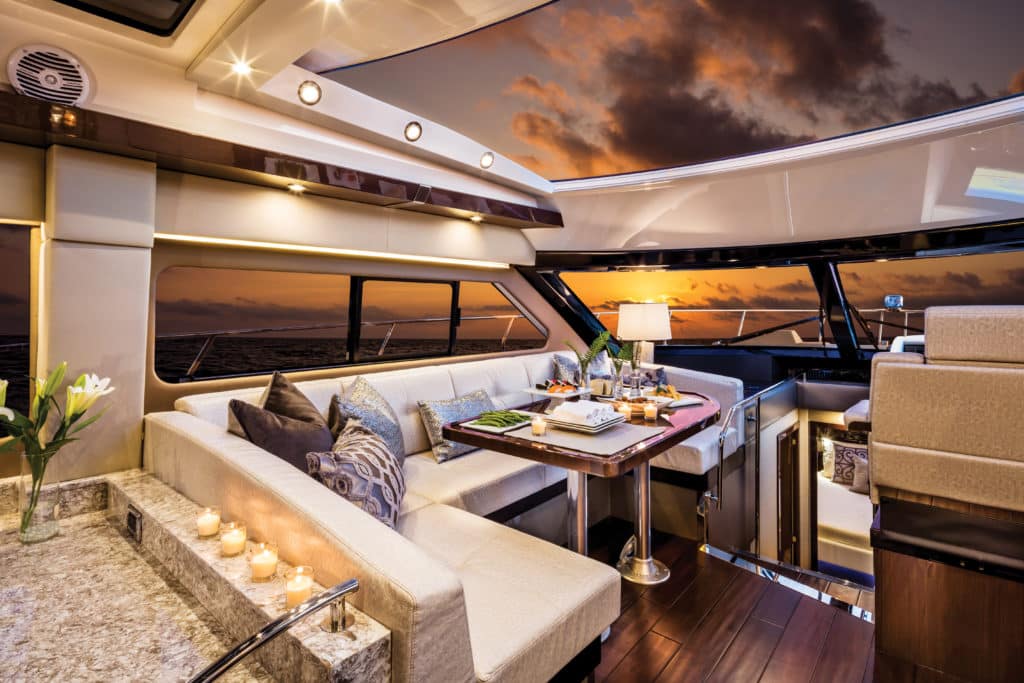
HISTORY OF CHANGE
Founded in 1954 by Charles Carter and George Verhagen, Carver started by building wooden runabouts. Genmar acquired the company in 1979, and Carver transitioned toward aft-cabin cruisers, including its then-largest 4207 Motor Yacht in 1985. The most recent generation of Carvers, launched during the past three years, has replaced every model built before 2012. The six new Carvers range from the C34 Command Bridge to the C52 Coupe flagship.
ENTERING A NEW ERA
The Carver C52 Coupe represents a fairly radical design evolution for the 63-year-old builder, which is on track to become serious competition for Italian and British yards. Working with Donald L. Blount and Associates, designers of renowned offshore yachts, Carver retooled its build processes and incorporated innovative design elements to create a serious bluewater cruiser. The plumb bow and low-riding superstructure give this next-gen Carver a contemporary look, and the interior also impresses, with such features as a private stairway to the master suite, a salon with 10-foot headroom and a sunroof.
CARVING A NEW PATH
“This isn’t your father’s Oldsmobile,” says Carver President and CEO Rob Parmentier, who has led the brand’s renaissance. “Carver always built a good-running boat, but they didn’t always put a lot of money into their components. We’ve invested a lot into raising the standards to what owners expect of a quality yacht.” The attention to detail shows on the C52 Coupe in “dozens of little things,” Parmentier says, from the weave of the carpet to the grade of stainless steel in the cleats. “We did a lot of listening to what owners want on a dream boat,” he says.
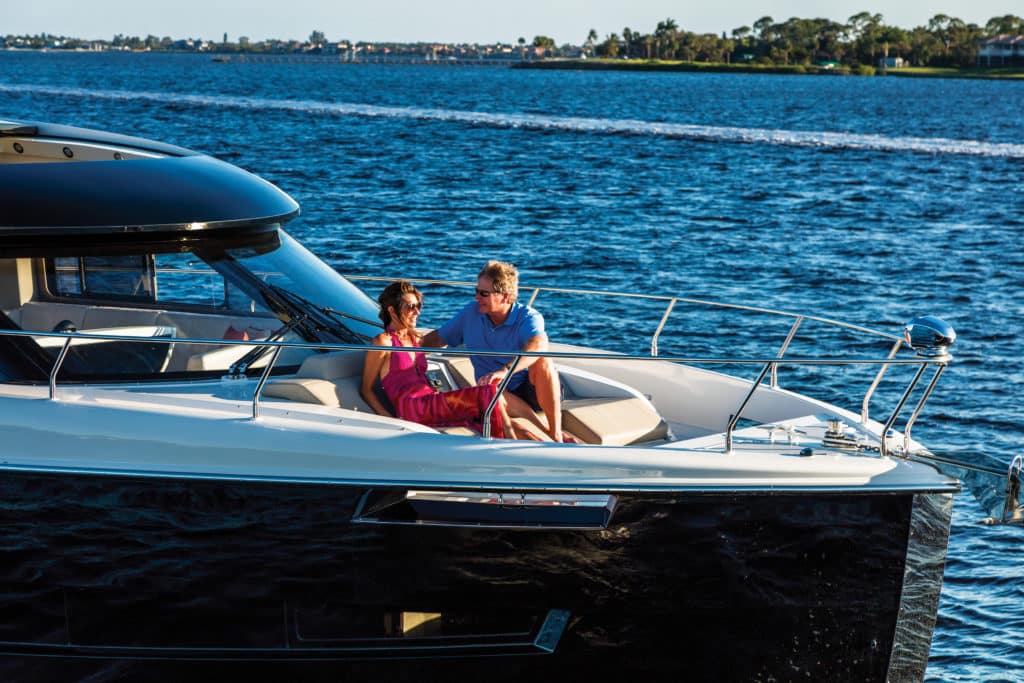
MATERIAL GIRL
The C52 Coupe represents a big stretch for Carver in terms of design and materials. The sunroof is the largest Carver has ever built. The builder also added skylights with a chromatic material that changes from clear to opaque. “The entire structure surrounding them is built of carbon fiber,” Delforge says. “We’ve never used that much carbon fiber in a Carver before. It may seem extreme, but we wanted to have the best quality and lightest weight possible for the coupe’s superstructure.”
REACHING THE OUTER LIMITS
The C52 Coupe’s exterior blends smart features of European and American design. The hull, with its vertical bow and swept-back superstructure, looks like some of the latest superyacht designs from the Netherlands and Italy. The high freeboard, however, gives the Carver the protected feel of a small ship with social spaces. Space and access to the great outdoors define the on-deck areas fore and aft. The full-beam swim platform is 6 feet 4 inches deep, allowing a group to congregate for watersports. The adjoining 160-square-foot cockpit is perfect for alfresco dining with friends. “We looked at one of Carver’s competitors, but it didn’t have enough space in the cockpit,” says Steve Grebow, who bought the first C52 Coupe. “That’s where we spend time, so it was an easy choice.” Carver designed a tender garage with easy access from the swim platform for equipment and toy stowage. The pop-up entrance also opens to the crew cabin aft, with a bunk, optional head and 6 feet 10 inches of headroom. The Grebows run Hull No. 1 themselves and use this space to transport four bicycles and water toys. When Carver decided to move from a flybridge to a coupe, the design implications involved more than just losing the upper deck. “Initially, there was nothing really special about the design of the superstructure,” Delforge says. “We decided that we could really distinguish it by making the sunroof as large as possible and then adding skylights behind.”
MAKING IT THEIR OWN
Steve and Janet Grebow searched high and low for a boat to replace their 40-foot Doral. “Our list of must-haves included a full-beam master suite along with two other staterooms, a rear galley on the main deck and a very large cockpit,” Steve says. “We looked at every boat between 48 and 52, but we didn’t like this or that. The Carver was the only one that checked all the boxes.” After taking delivery of Hull No. 1 in November, they did a two-week cruise through the Florida Keys. “So far, we love it,” Steve says. “We’re very happy with the quality of the build and the boat’s seaworthiness. We hit some 5-foot seas coming out of Miami, and the ride was solid.”
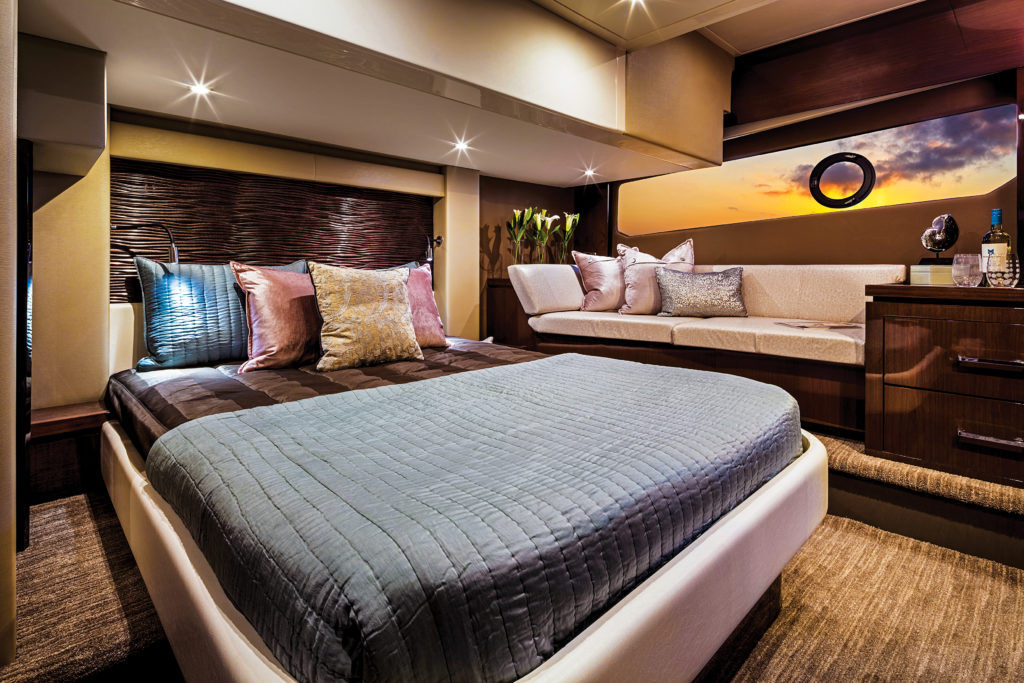
THE MARQUIS FACTOR
The carpenters and craftsmen at Carver Yachts’ Wisconsin factory are the same workers who build the more luxurious Marquis line. The skill sets and materials required for the quality detailing in the Marquis line have been transferred to new Carver models, Delforge says: “We took some of the design cues and materials developed for Marquis and use them on the new Carvers. Having Marquis has helped us build Carvers smarter with a higher level of luxury.”
HULL YES
Carver has always built seaworthy hulls for its cruisers and motoryachts. The C52 Coupe is no exception. Its modified V-hull with plumb bow is designed for big seas, while the full chine and rail on the running surface provide a dry ride. The company builds its hulls, moving from open molding to vacuum infusion with cored materials. Carver also uses an independent stringer system glued into the hull to minimize vibration and hull flex. “We made significant efforts to improve the ride quality,” Delforge says. “You really notice it while underway.” With the twin 600 hp Cummins, the C52 Coupe has a spirited top-end speed of 31 knots. A 27-knot cruise gives you a 268-nautical-mile range.
CONVERSATION STARTER
The salon is the centerpiece of this yacht, a gathering point that provides a clear line of sight from the galley aft to the double-seat helm station forward. The sunroof creates an open feel in the forward section of the salon, while the skylights aft, with 10 feet of headroom, make the interior feel like an atrium. With maple floors, black-cherry cabinets and windows all around, the C52 Coupe begins to feel more like a waterfront apartment than a yacht. Abaft the sunroof, the fixed aft skylights are one of the salon’s most impressive features. The glass panels incorporate Switch Shield technology that turns them from clear to opaque at the touch of a button. “We wanted to maximize the feeling of being outside,” Delforge says. “Due to the 10-foot ceiling height, curtains were not an option. So we went with switchable glass.” Good choice, as it really lights up the salon.
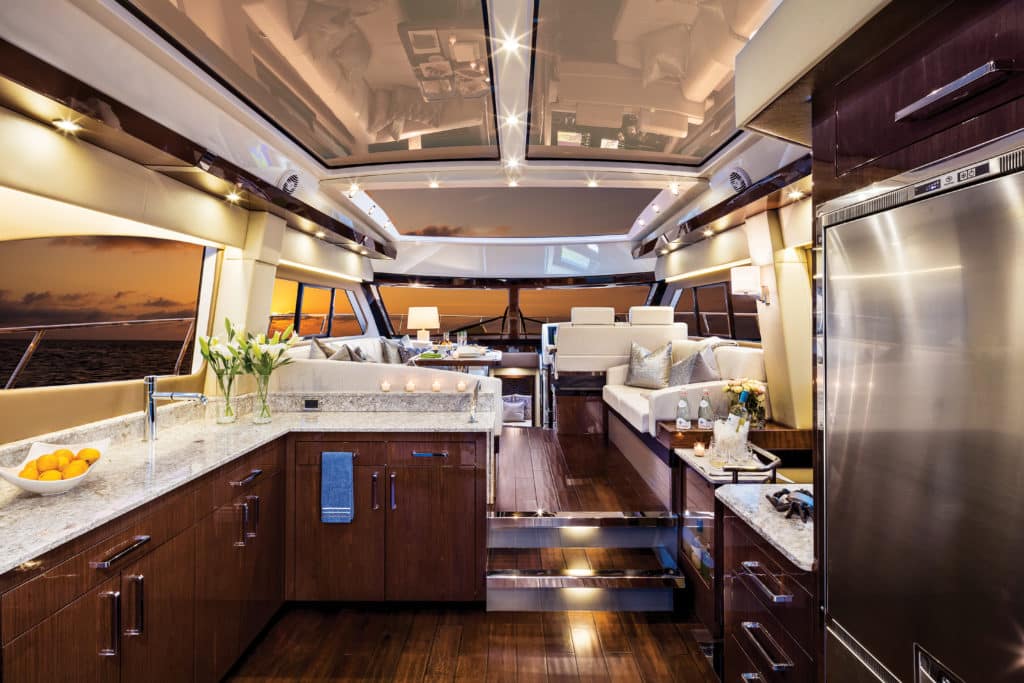
PRIVATE AFFAIRS
To maximize the space of the heads in the two staterooms forward and the master suite aft, Carver designed a separate staircase to the master. The solution not only gave the owners privacy, but also added 3 feet to the width of each head. The master suite feels big for a 52-foot yacht too, with a windowside lounge, cabinets and an en suite. A sculpted headboard on the bed, side windows and a glass-enclosed shower with rainforest shower head and vanity make this space a sanctuary.
VIP AFFAIRS
Carver included lounges, an en suite (with a skylight over the all-glass shower stall) and cherry- wood dressers along both sides of the VIP stateroom. It isn’t as spacious as the master, but it makes a wonderful weekend apartment.








